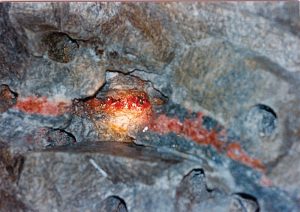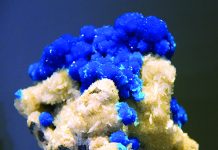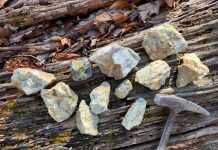
How rare is rhodochrosite? An example is the Alma Rose, from the Sweet Home mine in Colorado, and the third member of Rhodochrosite Royalty. It can be seen on display in the Rice Northwest Gem and Mineral Museum in Hillsboro, Oregon.
I first saw it at the Tucson Show in 1994. It was mined by Bryan Lees of Collector’s Edge. The King is in the Denver Museum of Nature and Science courtesy of the Coors Family. The Alma Queen, after passing through several hands, is now in the Houston Museum.
A Superb Specimen

Unlike the King with its single large rhodochrosite crystal, the Alma Rose is blessed with a cluster of sharp three-inch rhombs of very fine color interlocked to form a grouping of crystals some six inches across.
Each rhodochrosite is individual and sharp enough so each can be enjoyed, yet the cluster is undamaged and positioned so it is a wonderful example of the rhombic form of this manganese carbonate.
As if the cluster of crystals is not enough, a single rhodochrosite rhomb of matching size and color sits nearby as if refusing to join the cluster. This single crystal simply adds to the overall beauty of the specimen.
The rock matrix is completely covered and hidden by bright small quartz crystals.
Among all the quartz crystals are small contrasting dark sulfide crystals and a scattering of small colorful fluorite cubes.
To add a finishing touch, the final solutions released a scattering of small crystallized fine pale yellow stibnite sprays which developed randomly on and around the rhodochrosite. These contrast with but do not detract from the overall beauty of the specimen.

Delicate Digging
Just how such a perfect undamaged specimen can be extracted from its rock prison without damage is strong evidence of how far we have progressed in specimen recovery these last decades.
As an early collector, my tools included hammers and chisels, pry bars, and wedges. If you found a fine specimen on the exposed side of a vein opening, the difficulty to extract an undamaged specimen was obvious.
Today, with modern tools, such removal of the Alma King and Alma Rose was accomplished without serious damage to any of the exposed crystals.
The Alma Rose was on a solid rock wall, one side of a crystallized vein.

Removing the Rose
To remove such a beauty undamaged, miners employed power drills, diamond saws and hydraulic wedges. Keep in mind any serious vibrations of the rock holding the crystals would be fatal since rhodochrosite has perfect cleavage and any stress might cause crystals to part. This is what happened to the Alma King before it was ever exposed.
It was very lucky to have dropped in the vein untouched.
For the Alma Rose, drilling had to start well away from the open vein, which was first covered to protect it. Holes were drilled all around the wall section encircling the open vein. These served as a guide for the diamond saws that cut deeply into the wall rock. Slowly, the cut openings could be wedged open and more cutting was done to get behind the vein.
Once the entire vein section had been undercut it was broken loose from the wall with its still intact crystals. It could be carefully removed and taken to the specimen preparation lab at Collector’s Edge where trimming excess rock was slowly done, reducing the specimen to a manageable size and weight. Further trimming and shaping were done until the surface was exposed and crystals could be seen in all their beauty. With proper cleaning and shaping the Alma Rose was ready to be displayed.
This story about how rare is rhodochrosite appeared in Rock & Gem magazine. Click here to subscribe. Story by Bob Jones.















